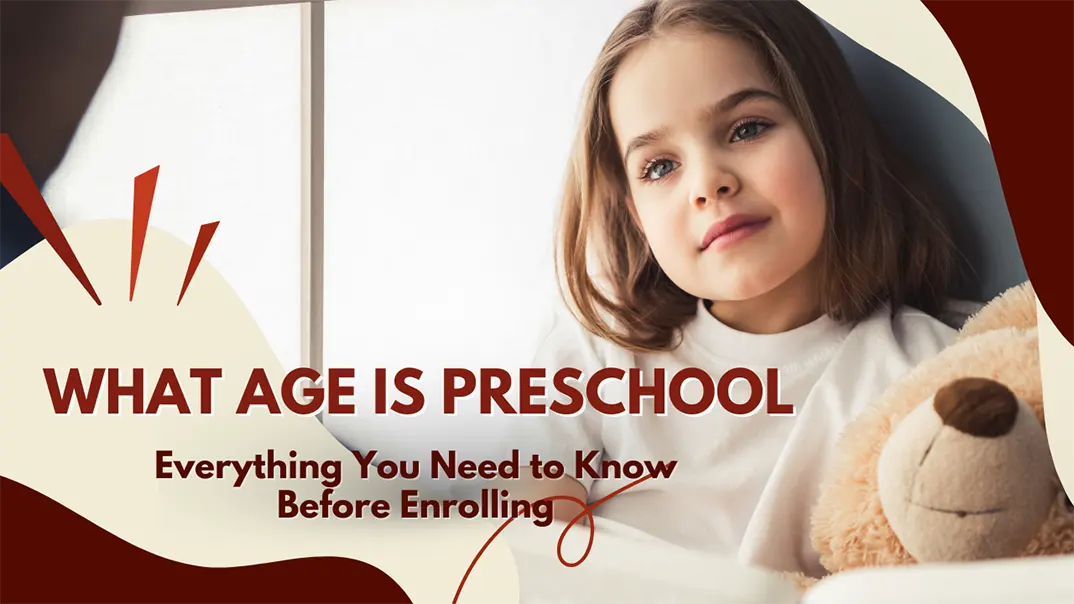Wondering if your child is ready for preschool? You’re not alone. One of the most common questions parents ask is, “What age is preschool?” With so much information—and sometimes misinformation—out there, it’s easy to feel confused.
The typical preschool age ranges from 2.5 to 5 years old, though the exact age can vary based on your child’s development and the program’s requirements. Preschool is designed to bridge the gap between toddlerhood and kindergarten, helping young learners develop essential social, cognitive, and motor skills. Understanding what preschool age means can help you make confident, informed choices for your child’s future.
Whether you’re planning ahead or trying to decide if now is the right time, knowing what age is preschool is the first step in making a confident, informed decision. Keep reading to feel empowered and confident about your child’s early education journey!
What Age Is Preschool?
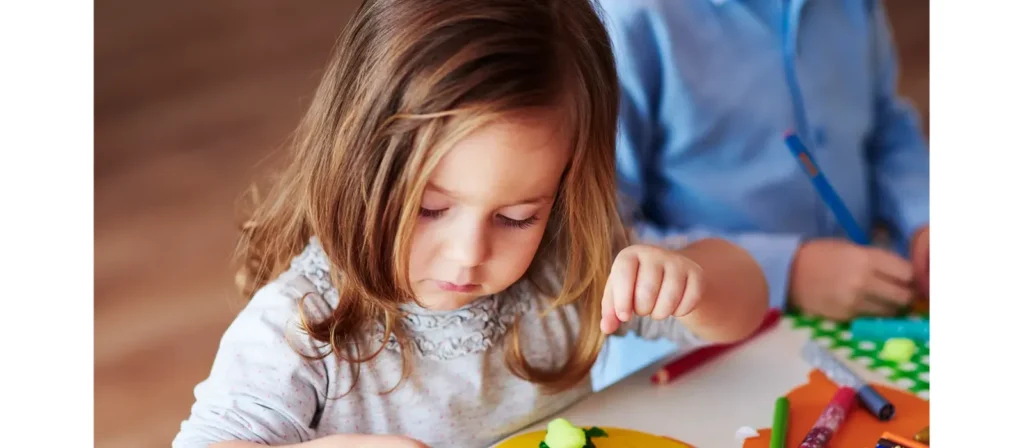
Preschool age typically refers to children between 2.5 and 5 years old, though the exact age can vary depending on the country, school system, and individual readiness. This period marks a crucial phase in early childhood development when children begin transitioning from home or daycare to more structured learning environments. But while these numbers offer a general guideline, the best preschool age for your child may depend on their unique developmental milestones and temperament.
Preschool is designed to introduce children to basic academic concepts, cooperative play, and classroom routines in a fun, nurturing environment. At this stage, kids learn how to follow directions, share, express themselves verbally, and build attention spans—all of which are foundational skills for kindergarten and beyond.
Another factor to consider when determining the right preschool age is your child’s personality and social maturity. Some children thrive in group settings early on, while others may benefit from waiting an extra year. Observing your child’s behavior and consulting with pediatricians or early childhood educators can provide helpful insight.
Ultimately, the answer to “what age is preschool?” isn’t one-size-fits-all. It’s about balancing age guidelines with developmental readiness, family needs, and program availability to choose the ideal time for your child to begin their preschool journey.
Preschool Age Around the World
The definition of preschool age isn’t the same everywhere—it varies widely depending on cultural expectations, education systems, and local policies.
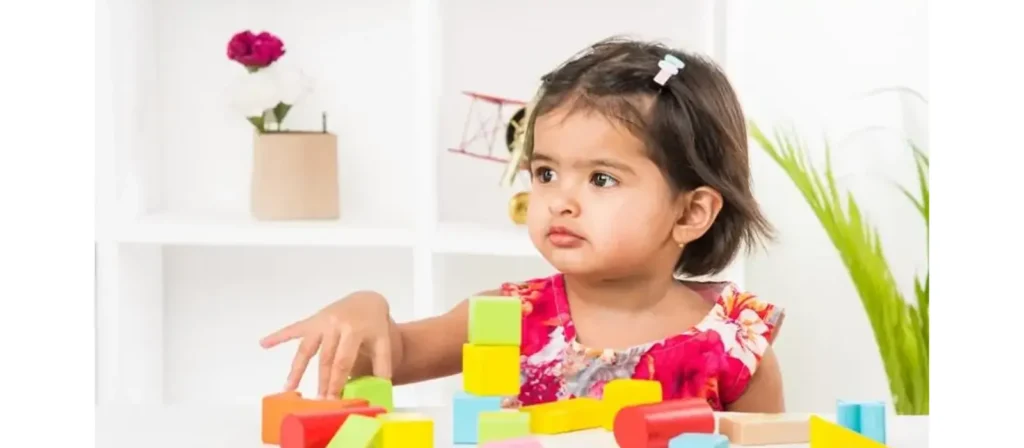
- United States
In the United States, preschool typically serves children between the ages of 3 and 5 years old. Most public preschool programs begin at age 4, often as part of pre-kindergarten (Pre-K) initiatives. Some private and daycare-based programs start as early as 2.5 years, especially if the child is potty-trained. Enrollment is voluntary, and the programs vary by state in terms of funding, curriculum, and structure. - United Kingdom
In the UK, preschool is often referred to as nursery or early years education. Children usually start between 3 and 4 years old, with universal funding available for 15 to 30 hours a week starting the term after their third birthday. However, some programs accept children from age 2, particularly in England, where funded childcare may be available for eligible families. - Canada
Canada doesn’t have a standardized preschool system across provinces. Most children attend preschool between the ages of 3 and 5, although some private settings offer options for 2-year-olds. Public funding and availability vary by province. For instance, Ontario offers full-day kindergarten starting at age 4, which many families use in place of preschool. - Australia
In Australia, preschool age typically ranges from 3 to 5 years old, depending on the state or territory. The year before kindergarten is often referred to as “preschool” or “kindergarten” itself, and most children start at age 4. Programs are usually part-time and government-supported, aiming to prepare kids for formal schooling. - Germany
Germany offers Kita (Kindertagesstätte) programs for children starting at a very young age, but preschool, known as Kindergarten, generally begins around 3 years old and lasts until the child starts school at 6. Attendance isn’t mandatory, but it’s widely utilized and highly structured. - Japan
Preschool age in Japan spans from 3 to 5 years, and many children attend yōchien (kindergarten) or hoikuen (nursery school). While yōchien focuses more on education, hoikuen supports working parents with extended care. These programs are vital for preparing children for Japan’s rigorous elementary school system. - India
In India, the preschool age usually starts around 2.5 to 3 years, with programs called nursery, lower kindergarten (LKG), and upper kindergarten (UKG). By the age of 5 or 6, children transition to primary school. Preschool education is becoming more formalized, particularly in urban areas. - France
France has a well-developed public preschool system called école maternelle, which is free and begins at age 3. Preschool is considered a critical part of the education system and continues until the child is 6, when compulsory elementary education starts. - China
Preschool age in China typically ranges from 3 to 6 years, with kindergartens (幼儿园) divided into three levels by age. The emphasis is on socialization, basic academics, and group activities. Urban areas often offer more structured and competitive programs than rural ones.
Benefits of Starting Preschool at the Right Age
Starting preschool at the right time can have a profound impact on a child’s development and long-term educational success. When children begin school during the appropriate preschool age, they are more likely to thrive academically, socially, and emotionally.
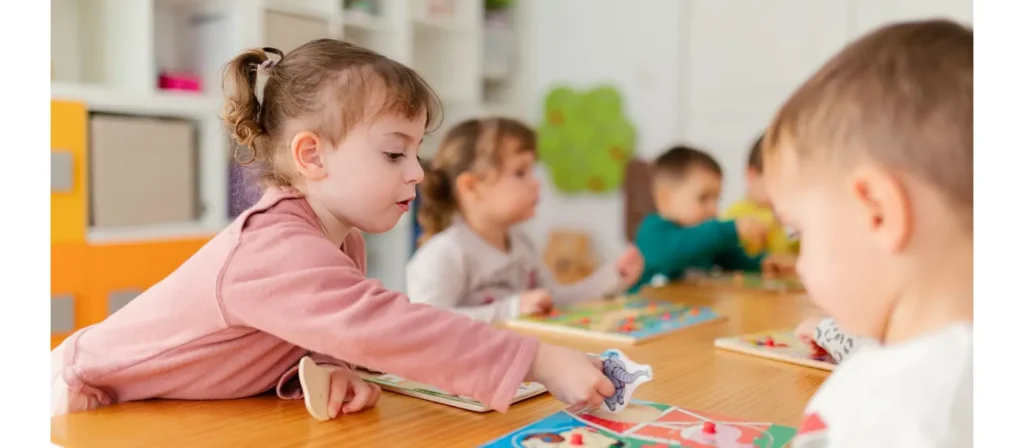
Developmental Readiness Enhances Learning
Children who enter preschool when they are developmentally ready—typically between 3 and 5 years old—tend to absorb and retain information more effectively. They have longer attention spans, are more emotionally regulated, and can follow classroom routines. This sets them up for a positive first learning experience, which can foster a love for school that continues for years.
Better Social Integration
At the right preschool age, children are naturally more curious about others and eager to form friendships. Entering preschool at this time helps them build strong interpersonal skills. They learn to navigate group dynamics, share classroom toys, resolve conflicts, and express their needs respectfully. Starting too early or too late may hinder this social development, leading to feelings of frustration or isolation.
Improved Emotional Confidence
Preschoolers who start at the right age are usually more comfortable being away from parents for extended periods. They are more likely to adjust smoothly to the new environment, routines, and authority figures, which boosts their emotional resilience. This kind of confident independence is essential as children prepare for kindergarten and formal schooling.
Maximized Learning Opportunities
Preschool programs are specifically designed to align with the developmental stages of children in the preschool age group. By enrolling at the optimal age, children can take full advantage of age-appropriate learning experiences. Whether it’s identifying letters, understanding patterns, or engaging in imaginative play, each activity supports growth in a way that feels natural and enjoyable.
Stronger Transition to Kindergarten
Starting preschool at the ideal time builds a strong foundation for kindergarten. Children become familiar with classroom norms, such as sitting in a group, raising hands, and working on structured tasks. This smooth transition helps prevent the academic and behavioral challenges that sometimes arise when children jump directly into a more formal education setting without the benefit of preschool.
ความสบายใจของพ่อแม่
Parents also benefit when their child enters preschool at the right age. Knowing that your child is developmentally ready and emotionally prepared allows you to feel more confident in the decision. It also makes the school experience more enjoyable for everyone involved, from morning drop-offs to teacher interactions.
Preschool vs. Pre-K vs. Kindergarten: What’s the Difference?
When navigating early childhood education, terms like preschool, Pre-K, and kindergarten often get used interchangeably. But they refer to distinct stages in a child’s learning journey—each with its focus, age range, and goals. Understanding these differences is essential when trying to determine the right preschool age and educational pathway for your child.
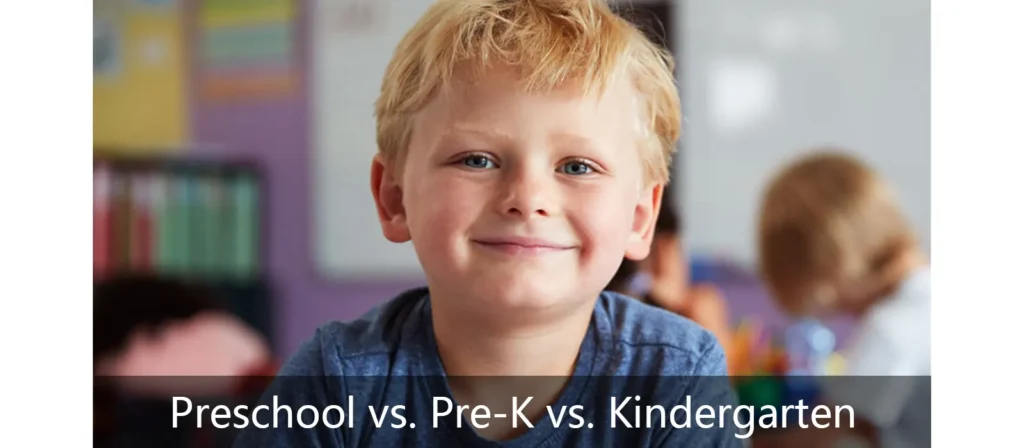
โรงเรียนอนุบาล
Preschool is generally the first step into structured education for children. It usually welcomes kids between the ages of 2.5 to 5 years, depending on the program. The primary goal of preschool is socialization, emotional development, and introduction to learning through play. Activities often focus on motor skills, basic concepts like colors and shapes, and learning routines such as sitting in a circle, taking turns, or following simple instructions. Preschool can be part-time or full-time, and it’s often seen as a gentle introduction to group learning.
- Typical age: 2.5–5 years
- จุดสนใจ: Social-emotional development, play, basic pre-academic skills
- กำหนดการ: Often part-time or half-day programs
Pre-K (Pre-Kindergarten)
Pre-K serves children closer to 4 to 5 years old, typically in the year just before kindergarten. While it shares similarities with preschool, Pre-K is more academically focused and prepares children for the structure of formal schooling. Pre-K programs often introduce early literacy, pre-math skills, basic science concepts, and more structured group activities. The preschool age overlaps with Pre-K, but Pre-K tends to emphasize school readiness more directly.
- Typical age: 4–5 years
- จุดสนใจ: Early academic skills, routines, independence
- กำหนดการ: May be full-day or part-day
Kindergarten
Kindergarten is usually the first year of compulsory education in many countries and is designed for children around 5 to 6 years old. Unlike preschool and Pre-K, which may be optional, kindergarten is often part of the public school system and involves a more formal curriculum. Children are expected to have foundational social skills and basic knowledge that enables them to follow lessons, work in groups, and begin reading and math.
- Typical age: 5–6 years
- จุดสนใจ: Foundational academics, structured learning, classroom behavior
- กำหนดการ: Full-day programs (in most school systems)
ความแตกต่างที่สำคัญโดยย่อ
| Program | Typical Age Range | Focus Areas | โครงสร้าง |
|---|---|---|---|
| โรงเรียนอนุบาล | 2.5 – 5 years | Social skills, play-based learning | Flexible, less formal |
| ก่อนวัยอนุบาล | 4 – 5 years | School readiness, early academics | More structured |
| Kindergarten | 5 – 6 years | Literacy, math, critical thinking skills | Formal, part of school |
Skills Developed in Preschool
Preschool is much more than finger painting and storytime—it’s a vital phase where children at the preschool age build foundational skills that prepare them for future academic and social success. These skills span multiple domains, including cognitive, emotional, physical, and interpersonal development. Let’s explore what children gain during their preschool years.
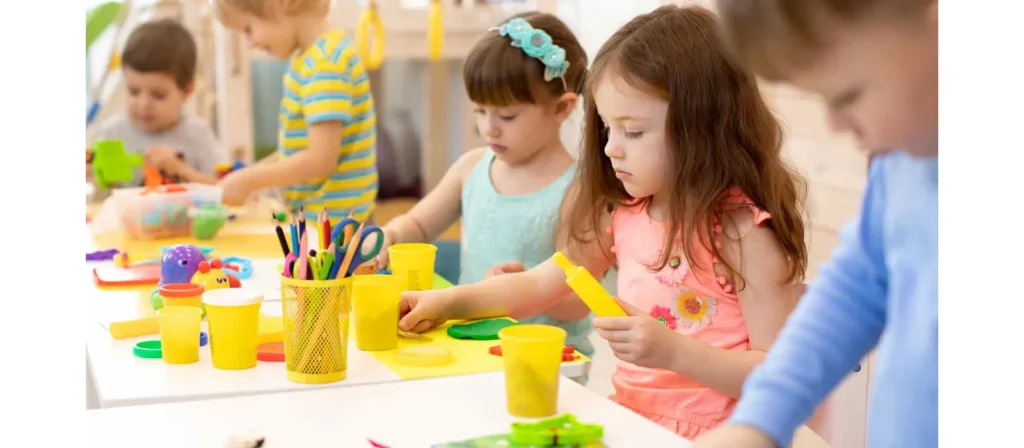
- ทักษะด้านภาษาและการสื่อสาร
At the preschool age, children’s vocabulary expands rapidly. Through songs, stories, show-and-tell, and group conversations, they learn to articulate thoughts, ask questions, follow instructions, and engage in back-and-forth communication. Preschool encourages expressive and receptive language development, setting the stage for strong reading and writing abilities in later grades. - Early Literacy and Numeracy
Children begin recognizing letters, sounds, and numbers, often learning to write their names and count objects in their environment. While formal academics are not the primary focus, preschool introduces early literacy and math through fun, hands-on activities—think puzzles, rhymes, matching games, and counting songs. - ทักษะทางสังคมและอารมณ์
Preschool is a child’s first structured social experience outside of the family. At this stage, children learn to make friends, cooperate, express feelings appropriately, and manage minor conflicts. These skills are nurtured through group play, circle time, and guided interactions with peers and teachers, all of which help foster emotional intelligence and empathy. - Self-Regulation and Attention Span
One of the essential developmental milestones at the preschool age is learning to control impulses and focus on tasks. Preschool routines help children learn patience, follow multi-step directions, and transition between activities. They begin to understand boundaries and expectations, which prepares them for more formal schooling environments. - Independence and Confidence
Simple responsibilities—like hanging up their backpack, washing hands before snack time, or choosing a learning center—help preschoolers develop independence. As they navigate these small tasks successfully, their confidence grows. Teachers also encourage children to make choices and solve simple problems, reinforcing self-reliance and resilience. - ทักษะการเคลื่อนไหวที่ดี
Using scissors, drawing with crayons, building with small blocks, or lacing beads all help children refine their fine motor coordination. These activities are critical for future skills like writing, typing, and even self-care routines like buttoning clothes or brushing teeth. - ทักษะการเคลื่อนไหวร่างกายโดยรวม
Preschool also promotes physical development through movement-based activities like running, jumping, dancing, and climbing. Outdoor play and physical education help build strength, coordination, and spatial awareness, which are vital for healthy physical growth. - Creative and Critical Thinking
Imaginative play, storytelling, art, and open-ended questions are all part of a preschool curriculum designed to boost creativity and cognitive flexibility. Children are encouraged to explore, hypothesize, and think critically about the world around them.
Assessing Your Child’s Readiness for Preschool
Deciding whether your child is ready to begin preschool is a major milestone for any family. While age provides a general guideline, true readiness goes beyond just hitting a number. The right preschool age can vary from child to child, depending on their developmental progress, personality, and life experience. Assessing your child’s physical, emotional, and cognitive readiness will help ensure a smoother, more positive start to their educational journey.
Signs Your Child Is Ready for Preschool
Every child develops at their own pace, but there are key indicators that can suggest whether your little one is ready to thrive in a สภาพแวดล้อมก่อนวัยเรียน. Here are some common signs of readiness:

- Comfort with Separation
One of the biggest hurdles for many parents and children is separation anxiety. A child who is ready for preschool can usually handle being apart from parents or caregivers for several hours without becoming overly distressed. While some initial nervousness is normal, your child should recover fairly quickly once engaged in activities. - Basic Independence
Children at the preschool age who are ready to start school often show early signs of independence. This can include feeding themselves, attempting to dress, washing hands, and using the restroom with minimal assistance. These small acts of self-sufficiency help children feel confident in a group setting. - Ability to Communicate Needs
Being able to express feelings, ask for help, and understand simple instructions is a crucial part of preschool readiness. Even if their language isn’t perfect, a child should be able to make their needs known through words, gestures, or signs. - Interest in Other Children
Social curiosity is another strong indicator. A child who is eager to play with others, share toys, and participate in group activities is likely to enjoy and benefit from the สภาพแวดล้อมก่อนวัยเรียน. While shyness is normal, a readiness to interact—even on a small scale—is key. - Follows Simple Directions
Preschool activities often involve group instruction. Children who can listen to and follow basic directions—like “put your toy away” or “sit on the mat”—are more likely to succeed in the structured routines of the classroom. - Shows Curiosity and Eagerness to Learn
If your child asks lots of questions, enjoys storytime, or is fascinated by puzzles and crafts, that’s a clear sign they’re ready to engage in preschool learning. Curiosity fuels learning, and at the right preschool age, children are naturally eager to explore new things. - Has Enough Energy and Stamina
Preschool can be surprisingly busy! From music and movement to outdoor play and arts and crafts, the day is packed with activities. Children who are ready for preschool typically have the stamina to keep up without needing frequent naps or downtime. - Handles Transitions Fairly Well
Daily preschool life involves moving from one activity to another—circle time to snack, playtime to cleanup. Children who can manage these transitions without major meltdowns show emotional readiness for a classroom routine.
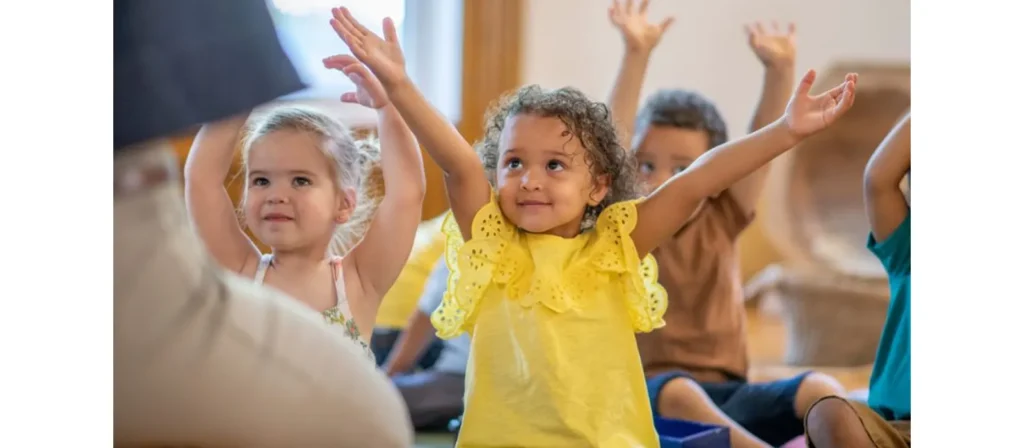
Questions to Help You Decide
Not every child who reaches the typical preschool age is automatically ready to begin. Preschool readiness is about more than age—it’s about emotional maturity, communication skills, independence, and the ability to thrive in a group setting. These categorized questions will help you assess your child’s readiness with clarity and confidence.
ทักษะทางสังคม
- Can your child engage in basic conversations with both adults and other children?
- Does your child enjoy playing with peers, sharing toys, and taking turns?
- Is your child able to follow simple instructions?
Emotional Readiness
- Is your child comfortable being away from you for short periods?
- Can they express their feelings using words rather than actions?
- Can your child transition from one activity to another without becoming overly upset?
ทักษะการสื่อสาร
- Can your child ask for help or express needs like hunger, thirst, or needing the bathroom?
- Do they understand basic questions and respond appropriately?
- Can they listen during story time or group activities without constant interruption?
ความเป็นอิสระ
- Is your child able to complete simple tasks independently, such as dressing or washing hands?
- Can they manage basic self-care routines like using the toilet or eating on their own?
- Do they follow a daily routine at home with minimal resistance?
Cognitive and Physical Readiness
- Can your child concentrate on a task or activity for at least 5–10 minutes?
- Do they enjoy puzzles, books, or creative play that involves problem-solving?
- Are they physically active and capable of safely using playground equipment?
How to Help Your Child Prepare for Preschool?
Starting preschool is a big transition, both for children and parents. While reaching the preschool age is an important milestone, emotional readiness and preparation play a critical role in making that first school experience a positive one. Fortunately, there are many simple, effective ways you can help your child feel confident and excited about their preschool journey.

Establish a Predictable Daily Routine
Preschool follows a structured schedule, so helping your child get used to consistent routines at home will make the transition smoother. Set regular times for waking up, eating meals, napping, and bedtime. Practice transitioning between activities to mimic the flow of a preschool day.
Practice Separation
If your child hasn’t spent much time apart from you, begin with short periods of separation. Leave them with a trusted relative, babysitter, or participate in short group classes like library storytime. Gradual exposure helps reduce anxiety and builds their confidence in new environments.
Build Social Confidence
At the preschool age, children are still learning how to interact with others. Arrange playdates, attend community events, or enroll in group activities where they can practice sharing, waiting their turn, and expressing themselves around peers. These experiences build crucial social-emotional skills for the classroom.
Encourage Independent Skills
Support your child in learning to do things independently, such as putting on their shoes, washing their hands, eating with utensils, or being potty-trained. These self-care tasks are often expected in preschool and help children feel more self-assured.
Visit the Preschool Together
If possible, schedule a visit to the preschool before the first day. Let your child explore the classroom, meet the teacher, and become familiar with the surroundings. This reduces fear of the unknown and builds a sense of comfort and excitement about their new space.
Read Books About Preschool
Storybooks are a gentle way to introduce children to the idea of preschool. Choose age-appropriate books that show characters starting school, meeting new friends, and having fun. These stories help normalize the experience and open up discussions about feelings and expectations.
Talk Positively About Preschool
Your attitude shapes your child’s perspective. Talk about preschool as an exciting adventure where they’ll play, learn, and make new friends. Reassure them that it’s okay to feel nervous, but emphasize the fun and positive experiences that await.
Practice Listening and Following Instructions
Preschool involves group instruction and structured activities. Reinforce skills like listening when others speak, cleaning up after playtime, or following two-step directions like “Pick up your toys and put them in the bin.” These small practices make the classroom experience less overwhelming.
Label and Prepare Belongings Together
Include your child in preparing for preschool by picking out a backpack, lunchbox, or clothes. Label items with their name and talk about what they’ll need each day. This gives them a sense of ownership and builds anticipation.
Be Patient and Encouraging
Finally, remember that adjustment takes time. Some children embrace preschool right away, while others may need a few weeks to settle in. Offer plenty of encouragement, celebrate small victories, and be patient through the ups and downs of this big transition.
What If My Child Isn’t Ready for Preschool?
Not every child is ready for preschool the moment they reach the typical preschool age, and that’s completely okay. Readiness isn’t defined by age alone; it’s a blend of emotional, social, physical, and developmental factors. If your child doesn’t seem prepared just yet, there are still many positive steps you can take to support their growth and ensure they’re set up for success when the time is right.

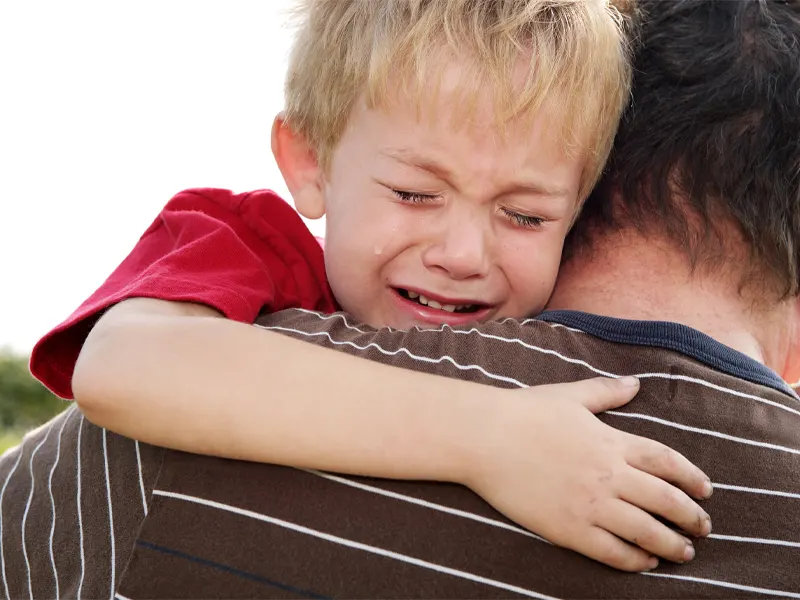
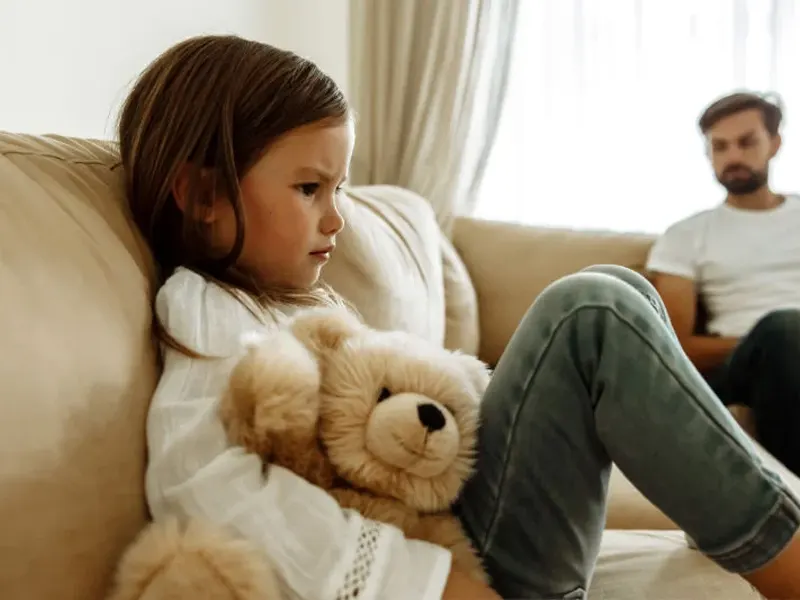
Delay Is Not a Defeat
Delaying preschool enrollment by a few months—or even a year—can give your child valuable time to mature. Some children benefit greatly from an extra year at home or in a less-structured childcare environment where they can grow at their own pace. This delay often leads to greater confidence and independence once they do start preschool.
Focus on Skill-Building at Home
Even outside of a classroom, you can work on developing preschool readiness skills at home. Set up routines, encourage playdates, and provide opportunities for your child to practice sharing, listening, and expressing emotions. Simple activities like puzzles, coloring, pretend play, and storytime all support the types of learning that take place in preschool.
Try Part-Time or Transitional Programs
If full-time preschool feels like too big of a leap, consider transitional options like part-time preschool, mommy-and-me classes, or structured playgroups. These programs offer a gentle introduction to social learning environments without the pressure of full-day attendance.
Talk to Professionals
If you’re unsure whether your child is simply adjusting more slowly or if there are developmental concerns, don’t hesitate to speak with your pediatrician or an early childhood education specialist. They can provide insights, perform assessments if necessary, and suggest tailored strategies based on your child’s needs.
Reevaluate in a Few Months
Readiness can change quickly. What feels like hesitation today may evolve into eagerness in just a few months. Keep observing your child, offering opportunities for gentle independence and socialization, and stay in communication with caregivers or pediatricians if you’re unsure.
Preschool Age Is a Range, Not a Deadline
It’s important to remember that preschool age is flexible. There’s no “perfect” age for every child. Some are eager to start socializing and learning at 3, while others may need more time to build confidence and independence. What matters most is that your child starts when they’re emotionally and developmentally prepared.
How to Choose the Right Preschool?
Once you’ve determined that your child is ready, the next big step is selecting a preschool that fits your child’s needs and your family’s values. Here’s a step-by-step guide to help you make an informed, confident choice.
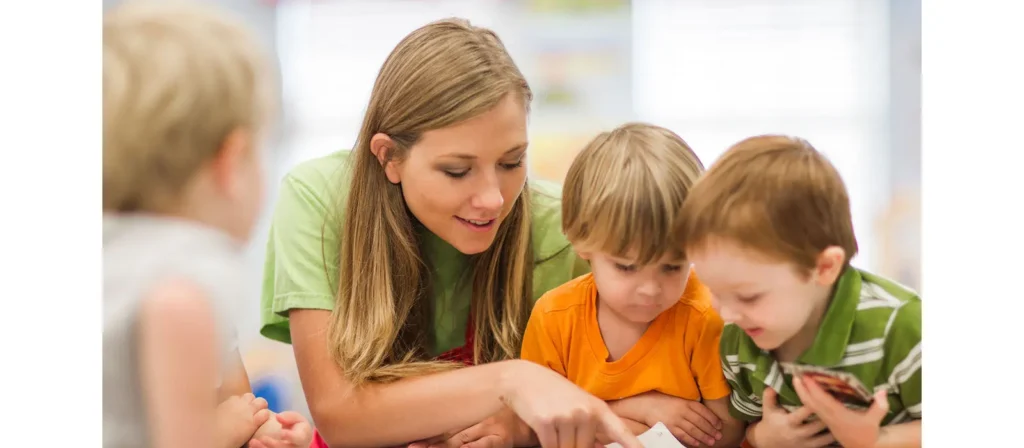
Define Your Priorities
Before visiting schools, consider what matters most to your family. Is it proximity to home or work? A play-based philosophy versus a structured curriculum? Do you want a religious, Montessori, Reggio Emilia, or language immersion approach? Knowing your values and your child’s personality will help narrow your options.
Look at the Preschool’s Philosophy and Curriculum
Preschools vary widely in how they approach learning. Some focus on academic readiness, others on creative exploration and social-emotional learning. Make sure the school’s philosophy aligns with your expectations and your child’s learning style.
Ask:
- How is the day structured?
- What subjects or skills are emphasized?
- How is play integrated into learning?
Evaluate Teacher Qualifications and Classroom Environment
Teachers play a critical role in the preschool experience. Look for programs where educators are trained in early childhood education and show warmth, patience, and genuine enthusiasm. Observe how teachers interact with students: Are they engaged, nurturing, and responsive?
What to look for:
- Qualifications: Do the teachers have degrees or certifications in early childhood education?
- Experience: How many years have they been working with preschool-age children?
- Approachability: Are they warm, patient, and engaged in children’s learning?
- Classroom setup: Are materials accessible? Are activity centers clearly labeled and inviting? Does the space encourage exploration and creativity?
- Emotional climate: Are children smiling, engaged, and respected? Positive energy in the room is a strong indicator of quality care.

Consider Class Size and Teacher-to-Child Ratio
Smaller class sizes and low teacher-to-child ratios typically mean more individual attention and better behavior management. Look for programs that follow best practices, such as:
- 1:6 ratio for 3-year-olds
- 1:8 ratio for 4- and 5-year-olds
Confirm Licensing, Accreditation, and Safety
Ensure the preschool is licensed by your local authority and follows regulations regarding health, hygiene, and child safety. Accreditation from organizations like NAEYC (National Association for the Education of Young Children) is a sign of high standards and ongoing quality control.
Match the Program to Your Child’s Personality
Your child’s individual needs and temperament should be a major factor in your decision. Some children thrive in energetic, social settings, while others may need more calm, intimate environments. Think about how your child handles new situations, sensory input, noise levels, and group dynamics. The right preschool will support your child’s development without overwhelming them, especially during the sensitive and formative preschool age years.
Evaluate the Daily Routine and Curriculum
A good preschool will offer a balance of structured and unstructured activities. Look for a sample daily schedule that includes:
- Free play and guided activities
- Outdoor time
- Circle time or group discussions
- Snack/lunch breaks
- Nap or rest time (if applicable)
This helps your child develop routine, self-regulation, and social-emotional skills.
Ask About Family Involvement
Strong schools often encourage family engagement through open houses, volunteer opportunities, or regular communication. Ask how teachers keep parents informed and whether there are opportunities for collaboration and feedback.
- How often do you receive progress updates or parent-teacher communication?
- Are parents invited to participate in activities or field trips?
- Is there an open-door policy for classroom visits?
- Are there parent-teacher conferences or events like art shows and graduation?
Visit the School in Person
A tour can tell you more than a website ever could. Watch how children interact, observe the general mood of the classroom, and imagine your child in that environment. Trust your instincts—if something feels off, explore other options.
Speak with Other Parents
Lastly, reach out to families who already attend or have recently graduated from the school. Ask about their experience, how their child adjusted, and whether the program delivered on its promises. Word-of-mouth reviews often provide honest insight into the school’s strengths and challenges, more than any brochure or website can offer.
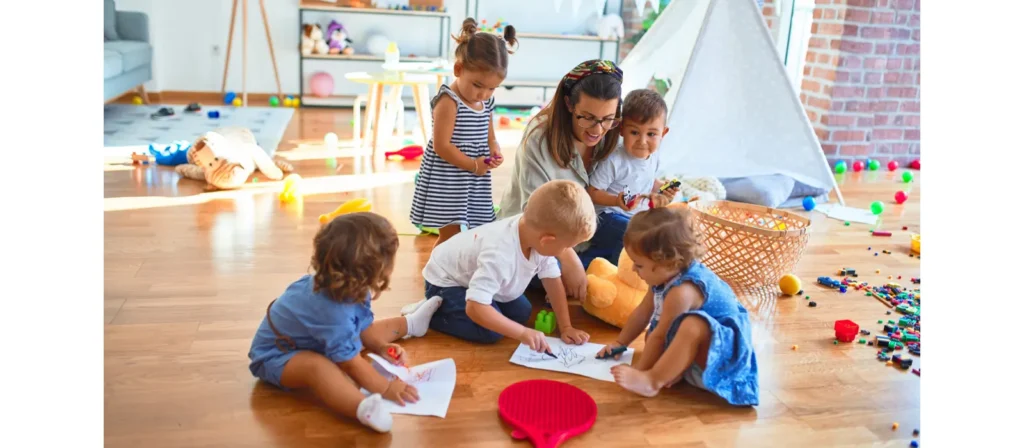
What Are the Different Types of Preschools?
Preschools come in many forms—each offering a unique approach to early learning. While all programs aim to support children during the preschool age, their teaching philosophies, classroom structures, and daily routines can differ dramatically. Understanding the most common preschool types will help you find a program that aligns with your child’s needs and your educational values.
Montessori Preschools
Based on the philosophy of ดร.มาเรีย มอนเตสซอรี่, these schools emphasize independence, self-discipline, and hands-on learning with specially designed materials.
- Ideal for: Children who enjoy structure, routine, and working independently
- จุดสนใจ: Life skills, sensory exploration, individualized learning
- สิ่งแวดล้อม: Calm, orderly, with mixed-age classrooms
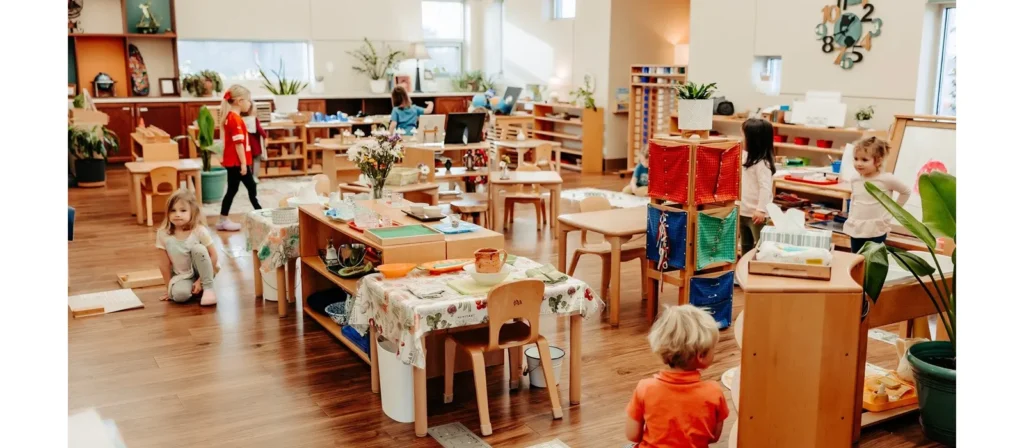
Reggio Emilia-Inspired Preschools
Originating in Italy, the แนวทางเรจจิโอเอมีเลีย views children as capable, curious learners. Education is project-based, collaborative, and highly influenced by the child’s own interests.
- Ideal for: Children who thrive in creative, expressive settings
- จุดสนใจ: Artistic expression, collaboration, child-led exploration
- สิ่งแวดล้อม: Open-ended materials, documentation of learning, strong family-school connection
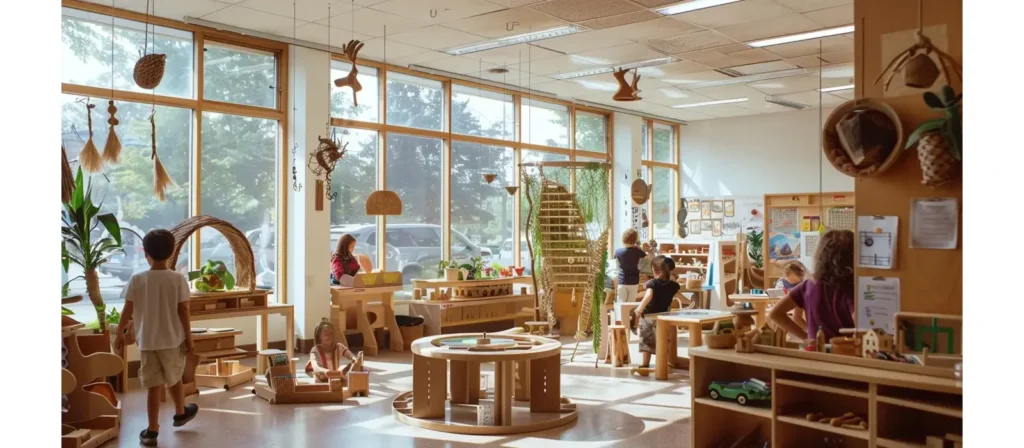
Waldorf Preschools
Waldorf education focuses on imagination, routine, and rhythm. Technology is usually limited, and the curriculum includes storytelling, nature exploration, and practical skills.
- Ideal for: Families seeking a holistic, nature-centered, and artistic environment
- จุดสนใจ: Imaginative play, seasonal rhythms, emotional development
- สิ่งแวดล้อม: Warm, natural materials, and predictable routines
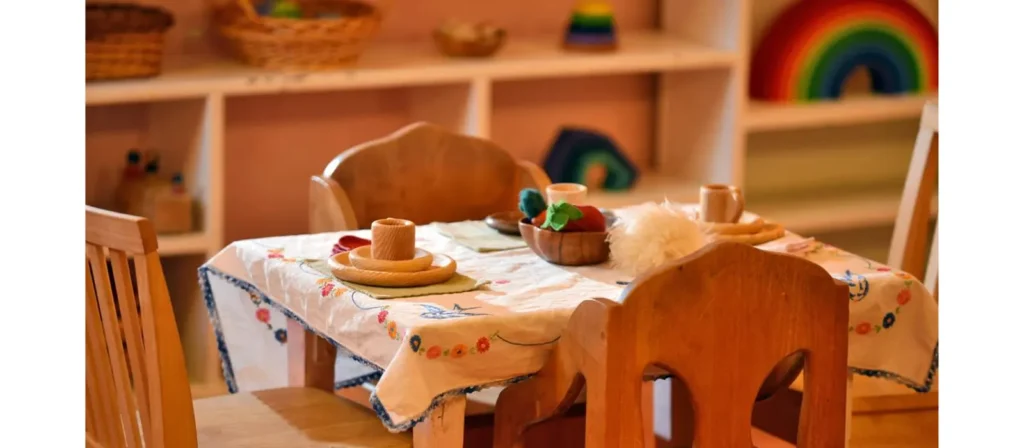
คำถามที่พบบ่อย
- What is the preschool age range?
Preschool age usually ranges from 3 to 5 years old, though some programs may accept children as young as 2.5, especially if they are potty trained and socially ready. - Is my child too young for preschool at 3 years old?
Not necessarily. Many children start preschool at 3, especially in play-based or part-time programs. Readiness depends more on developmental factors than age alone. - What skills should my child have before starting preschool?
Basic self-care (like hand washing), the ability to follow simple instructions, express needs, and interact with peers are key readiness indicators for children at the preschool age. - Does my child need to be potty-trained to attend preschool?
This varies by school. Some require full potty training, while others offer support for children still learning. It’s important to ask about the school’s specific policy. - How many days a week should my child attend preschool?
It depends on your child’s age and readiness. Younger children might start with 2–3 days per week, while older preschoolers preparing for kindergarten may benefit from a full-week program. - What are the benefits of starting preschool at the right age?
Starting preschool during the ideal preschool age helps build confidence, promotes social development, strengthens early learning skills, and makes the transition to kindergarten smoother. - Is preschool mandatory?
No, preschool is not mandatory in most countries, including the United States. However, many parents choose to enroll their child for social, emotional, and cognitive development. - No, preschool is not mandatory in most countries, including the United States. However, many parents choose to enroll their child for social, emotional, and cognitive development.
- What type of preschool is best for my child?
The best preschool depends on your child’s personality, learning style, and your family’s values. Options include Montessori, play-based, academic-focused, Reggio Emilia, Waldorf, and more. - Can I switch preschools if it’s not the right fit?
Yes. If your child isn’t thriving or the school environment doesn’t match your expectations, it’s okay to explore other options. Transitioning is common and often leads to better outcomes. - How do I prepare my child emotionally for preschool?
Talk positively about school, visit the classroom together, read preschool-themed books, establish routines, and practice short separations to build confidence and emotional resilience.
Conclusion: Trust the Timing That’s Right for Your Child
Understanding what age is preschool is about more than identifying a number—it’s about recognizing the developmental readiness, emotional maturity, and unique personality of your child. While most children begin preschool between ages 3 and 5, there’s no one-size-fits-all answer. What matters most is choosing a path that supports your child’s confidence, curiosity, and comfort.
Whether your child is eager to start group activities or still needs time to adjust to structured routines, your thoughtful observation and planning play a key role in their successful transition. From selecting the right program type to identifying signs of readiness, every step helps build a strong foundation for lifelong learning.
Take your time, ask the right questions, and trust your instincts as a parent. With the right preparation and support, your child’s preschool experience can be a joyful and meaningful beginning to their educational journey.

